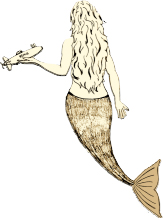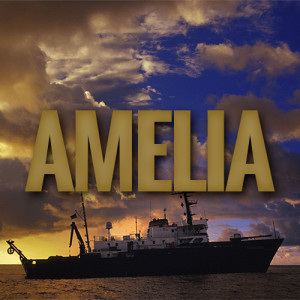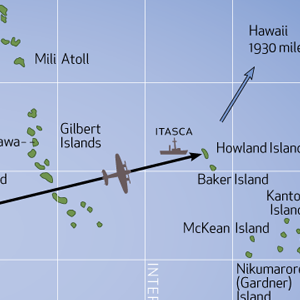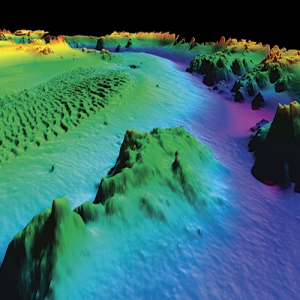Central Pacific Edition
Tribute Issue
With Gratitude to Cast & Crew
 Today we end operations in the Central Pacific after 42 days at sea (no April fooling!). We still have several day’s transit to Majuro where we will disembark, and most will have to wait a couple of days before we can catch a flight to Honolulu, and then home. So we have another week to go before seeing our families, a bit over seven weeks for most of us. Of course, Mermaid will be back at sea after just a day of demobilization (removing the WHOI equipment for shipping to Massachusetts) and will spend another couple of weeks transiting back to Singapore. It has been a long but rewarding voyage as we have added over 700 square-nm of new knowledge of the seafloor, learned new skills, made new friends, and enjoyed spending time with former shipmates. As we turn our bow west and head for port, I would like to acknowledge the efforts of “cast and crew” and express my gratitude for your good humor, professionalism, and companionship.
Today we end operations in the Central Pacific after 42 days at sea (no April fooling!). We still have several day’s transit to Majuro where we will disembark, and most will have to wait a couple of days before we can catch a flight to Honolulu, and then home. So we have another week to go before seeing our families, a bit over seven weeks for most of us. Of course, Mermaid will be back at sea after just a day of demobilization (removing the WHOI equipment for shipping to Massachusetts) and will spend another couple of weeks transiting back to Singapore. It has been a long but rewarding voyage as we have added over 700 square-nm of new knowledge of the seafloor, learned new skills, made new friends, and enjoyed spending time with former shipmates. As we turn our bow west and head for port, I would like to acknowledge the efforts of “cast and crew” and express my gratitude for your good humor, professionalism, and companionship.
For Captan Noe Flores and the crew of the Mermaid Vigilance, Bravo Zulu! In a letter I will be sending to their company, MMA, “Mermaid Vigilance, MMA and the officers and crew have all exceeded my expectations. The vessel performed flawlessly each and every day of the charter. Every customer need was fulfilled completely.” I cannot say enough about their dependable, trustworthy. and friendly service. Many, many thanks! (Also a special thanks to Ship Superintendent Alfher Hernandez of MMA for helping to get us underway and for the supply of Snyder’s Pretzels!)
Of course, none of this would have been possible without the support of Alan Eustace, explorer, adventurer, and scientist. Besides his financial backing, he was also a key participant. His time on board was well spent as he eagerly soaked up new knowledge about our technology and operations, and was a source of wisdom and decision making at every juncture. I valued his quick grasp of every situation and action-oriented conclusions. I hope to have the privilege of working together again in the future.
Here at sea, I had the opportunity to work with deep-sea autonomous vehicle technology provided by the Dalio Foundation and the team from WHOI. Greg Packard led the group, helped us understand how to efficiently use the system to maximum benefit, worked calmly though crises, and contributed to our decision making as the mission proceeded. Christopher Griner, Neil McPhee, and Mark Dennett worked tirelessly to deploy and recover REMUS, drop, survey, and recover transponders, and were great shipmates though it all.
Spence King led our operations with efficiency, grace, and good humor. All of his expertise as a mariner, U.S. Navy commanding officer, and manager was put to the test. His work began on this expedition back in December, but that doesn’t count many unpaid hours helping me get the project back to sea over the years. I have learned a lot from him about teamwork, management, and celestial navigation, though I fear I will never be his best student in the School of Hard Knots.
It was great to sail again with Tom Dettweiler and we were lucky to have his skill and experience on board. He and the WHOI team worked together seamlessly and Tom was a valued analyst of the sonar data, backing up Jeff Morris. Jeff led the processing and evaluation of the sonar imagery from REMUS, and gave us confidence that we were sorting out targets from geology and rocks from seafloor jetsam. He also proved to be our best drone pilot. Cap’n Joe Litchfield rounded out our operations team and provided a healthy dose of true seamanship as well as some “true” sea stories. He was a valuable assistant to Spence and a great shipmate. His stint as a basketball ref was wanting, however.
The Media Team led by Bill Mills and supported by Bryan “MacGyver” McCoy was everywhere. From hand-helds to pole cams to Go- Pros to drones, they covered the expedition from every angle. We enjoyed Bill’s company in 2002 and were glad to have him back. This time, we were able to share our videos with folks at home, which I know were appreciated. Bryan handled his first venture to sea with aplomb, and helped keep the network and just about everything else up & running at sea, sometimes with imaginative solutions drawn from his “Felix the Cat” bag of tricks.
This trip we had a fully functional Education Team led by Sallie Smith. In past expeditions our activities were kept under wraps by sponsors, but this time Alan supported a STEM outreach program and we took advantage of it. With help from Rockwell Collins and the SeaWord Foundation, Sallie and her cohorts, journalist Marika Lorraine and jack-of-many-trades Sue Morris shared learning modules and videos about sea life, remote sensing , weather, and oceanography with students and the interested public back home. Marika doubled as reporter for Passages, and was especially helpful with Spotlight interviews as well as professional intros for Bill’s videos. Sue, a three-time veteran of Amelia expeditions, also organized imagery and supported the REMUS team as an operations assistant.
 Also sailing for the third time were Rod Blocksome and Tom Vinson, The Radio Guys. With an array of communications gear, they did their Ham thing as well as support of the education outreach program with Skype calls to students and ISS communications. They also provided vital input to the navigation analysis effort, with the help of folks back in Iowa from the Collins Amateur Radio Club.
Also sailing for the third time were Rod Blocksome and Tom Vinson, The Radio Guys. With an array of communications gear, they did their Ham thing as well as support of the education outreach program with Skype calls to students and ISS communications. They also provided vital input to the navigation analysis effort, with the help of folks back in Iowa from the Collins Amateur Radio Club.
Another three-timer was Jon Thompson, who cheer-led every step of the way, and helped us collect Amelia-belia for posterity. Back for more abuse was Doc Pam Geddis, who was called upon a few times for (thankfully) minor scrapes, and was a great sailor and tolerable Amelia impersonator.
Of course, Captain Elgen Long joined us for the third time, and provided sage advice, tales of aviation adventure, and a ready fount of knowledge about Amelia, Fred, and the Electra.
We could not have managed without Charlotte Vick who handled ashore liaison and organized our re-supply mission and Alan’s trip to the site. It’s not easy finding vessels that can sail 1,600 miles with cargo at a moment’s notice, but she did it. Thanks to the captains and crews of SauVage and Machias for their help with that. Besides the critical stuff, Charlotte also made sure we had the little things from tissues to towels to chocolate that made life at sea a little easier. And she handled PR!
Also back home were Jenne James and Bethany Lacroix managing the website, communications, and details getting us underway. David Kling, Master of Coin, has kept the cash flowing smoothly. Louise Mnich took on the challenging task of negotiating and reviewing contracts, gave legal advice, and says she enjoyed it! We sure appreciated it! Also ashore answering questions and running Monte Carlos upon request was Professor Jeff Palshook, who we look to for Mat-Lab wizardry and expert historical research.
This expedition was launched on the foundation of two previous trips in 2002 and 2006, funded by Earhart Discovery and its sponsors and investors. Besides those on board who have supported the venture, Gary Bane, Julie Nelson, and Bruce Crawford have been providing help and guidance from shore. To get her we have finally completed the search we set out to accomplish in 1999, and improved our map of the deep seafloor by an area the size of the State of Connecticut. Thanks for your persistence and unflagging encouragement.
Last, but hardly least, our friends and families back ashore deserve our heartfelt appreciation for handling all of the domestic details we had to neglect and for continuing support and inspiration. We certainly all look forward to returning to home & hearth.
However, I predict we will all hope we can go to sea together again someday, and I surely will look forward to that opportunity. Thanks, shipmates all!
Dave Jourdan, President, Nauticos



